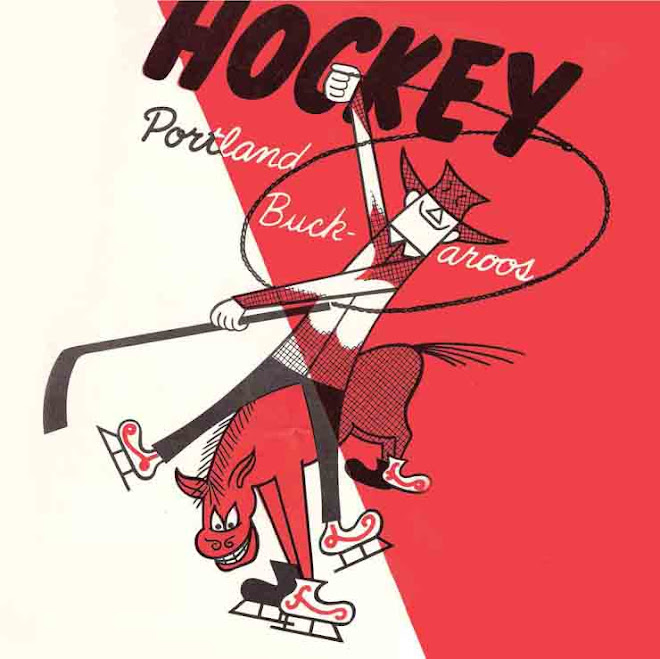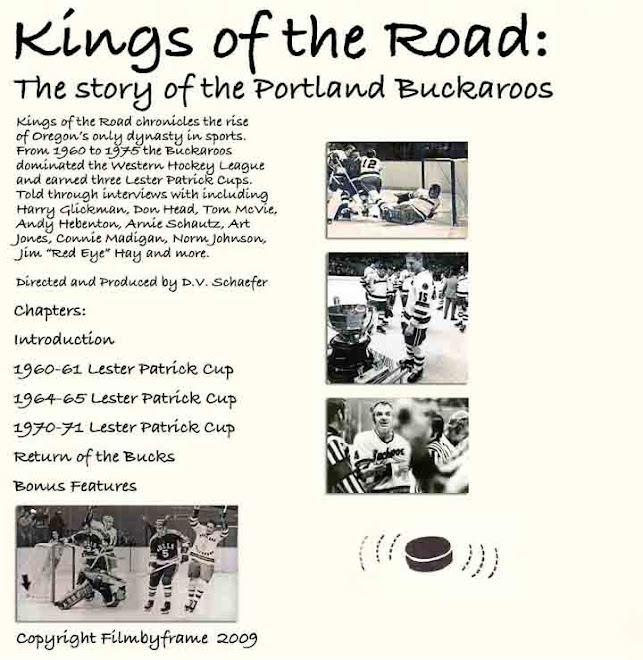Another Buckaroo roundup
Portland’s hockey greats return to Memorial Coliseum
By jason vondersmith
The Portland Tribune, Mar 12, 2009 (1 Reader comment)
(news photo)
COURTESY OF PORTLAND WINTER HAWKS
Cliff Schmautz (right) scores against the San Diego Gulls during the heyday of the Portland Buckaroos at Memorial Coliseum.
ADVERTISEMENTS
Stories abound about the Portland Buckaroos hockey team of the 1960s and early ‘70s – with a few embellishments here and there – and Harry Glickman can recall all sorts of them.
One year, Glickman, the team president who would later run the Trail Blazers, sat down with rough-and-rowdy defenseman Connie Madigan for a contract negotiation session. Madigan asked for $15,000, as Glickman remembers, and the boss offered him $14,000.
“He says, ‘Nope, 15,’ “ Glickman says. “I bumped it to $14,500. He says, ‘Nope, 15,’ and then I asked him to split the difference, make it $14,750, and he said, ‘Nope, 15.’
“I told him, ‘Connie, if I had offered you $20,000, you would still say ‘15.’ And, he says, ‘Yep.’ “
The two settled on a contract, and Madigan played another fabulous season for the Buckaroos, a cast of characters and standout players who enjoyed a long love affair with Portland sports fans.
Memories will be rekindled Saturday during “Buckaroos’ Salute” at the Portland Winter Hawks-Seattle game, set for 7 p.m. at Memorial Coliseum. The arena was home to many greats moments for the Buckaroos, who won eight division titles, placed second three times and captured three Lester Patrick Cups in the old Western Hockey League from 1960-61 to 1970-71.
The WHL these days is made up of junior players on their way up. The WHL Buckaroos consisted of professional players who called Portland home – as many of them still do.
They came, they played, they stayed and the Buckaroo dynasty has a special spot in the history of Oregon sports.
“For the 13 years we were all together, we won more games than any team in hockey. The runner-up was Montreal,” Glickman says. “They were a wonderful collection of athletes and people. I’m proud many of them stayed in Portland.”
The Buckaroos were formed in 1960 to correspond with the opening of the coliseum – and won their first Patrick Cup –and they ended play in spring 1974, the final two seasons as part of the Los Angeles Kings’ organization. During the first 12 years, the Buckaroos ran as an independent organization, making deals for players through loans, purchases and signings and attracting some of the best talent around, compared to the NHL and otherwise.
“Every year we were able to buy one,” Glickman says, of a player. “We were pretty aggressive … we wanted to own our own players and not rely on the NHL (to designate players). So we kept consistency.”
Stars included Madigan, Jim “Red Eye” Hay, Art Jones, Andy Hebenton and goalie Don Head. Jones, the team captain, was the WHL’s all-time leading scorer with 492 goals and 865 assists in 977 games, playing all 14 years of the Buckaroos.
Arnie Schmautz, another star along with his late brother, Cliff, still lives in Portland. He ran a roofing company that dates to his 1960-61 start – and he got big-time business after the Columbus Day storm of 1962.
Great glory years
About 25 former Buckaroos will be at the coliseum on Saturday. Video highlights will be shown during breaks in the Winter Hawk game. A DVD will be for sale. A signed championship banner will be raised.
Madigan, 74, has lived in Portland since he played here from 1964-74. He left briefly to play 20 games in the NHL with St. Louis in 1973, becoming the NHL’s oldest rookie ever at age 38. He retired in 2000 as a pipe fitter, although he still travels to Canada for a job occasionally.
He and “Red Eye” and former Buck Tommy McVie and other teammates often get together and share stories. McVie, a former NHL coach, still scouts for Boston, and lives in Vancouver, Wash.
Madigan played in Spokane, Los Angeles and Denver before joining the Buckaroos. He established himself as a tough guy who would body-check and fight anybody. He was a rival, but the rugged D-man quickly enamored himself with teammates by scoring a goal in his first game in 1964. He paired with “Red Eye” on the blueline for the first of many seasons, and the Buckaroos won their second Patrick Cup in 1964-65.
Madigan remembers playing in front of the huge coliseum crowds and the fanfare around town, and “we had a great coach in Hal Laycoe (1960-69),” he says. “He would always talk with you. I always respected that.”
In 1964-65, “we could have played in the NHL,” Madigan says, of the Buckaroos’ talent. The NHL started to expand from six teams in 1967, and the best WHL players began to find better jobs.
The coming of the Trail Blazers in 1970-71 didn’t necessarily take fans away from the Bucks, but the hockey team become less of an attraction on the city’s sports scene. That same year, the Buckaroos won their final Patrick Cup.
“The last year we were all together (1972-73), we didn’t make the playoffs, and it was total misery,” Glickman says.
Another version of the Buckaroos played in the 1920s, ‘30s and ‘40s. And after the WHL folded in 1974, a Buckaroos outfit competed in two fledgling semipro leagues, but folded.
When people think of the Buckaroos, they don’t think of those teams, only the great glory years of the 1960s and early ‘70s.
They think of Madigan, “Red Eye,” Jones, the Schmautz brothers, Hebenton, Head, Jack Bionda, McVie, Mike Donaldson, Arlo Goodwin, Bill Saunders, Gordon Fashoway, Larry Leach, Rick Foley, Norm Johnson, Dick Van Impe … the list goes on.
Portland’s hockey greats return to Memorial Coliseum
By jason vondersmith
The Portland Tribune, Mar 12, 2009 (1 Reader comment)
(news photo)
COURTESY OF PORTLAND WINTER HAWKS
Cliff Schmautz (right) scores against the San Diego Gulls during the heyday of the Portland Buckaroos at Memorial Coliseum.
ADVERTISEMENTS
Stories abound about the Portland Buckaroos hockey team of the 1960s and early ‘70s – with a few embellishments here and there – and Harry Glickman can recall all sorts of them.
One year, Glickman, the team president who would later run the Trail Blazers, sat down with rough-and-rowdy defenseman Connie Madigan for a contract negotiation session. Madigan asked for $15,000, as Glickman remembers, and the boss offered him $14,000.
“He says, ‘Nope, 15,’ “ Glickman says. “I bumped it to $14,500. He says, ‘Nope, 15,’ and then I asked him to split the difference, make it $14,750, and he said, ‘Nope, 15.’
“I told him, ‘Connie, if I had offered you $20,000, you would still say ‘15.’ And, he says, ‘Yep.’ “
The two settled on a contract, and Madigan played another fabulous season for the Buckaroos, a cast of characters and standout players who enjoyed a long love affair with Portland sports fans.
Memories will be rekindled Saturday during “Buckaroos’ Salute” at the Portland Winter Hawks-Seattle game, set for 7 p.m. at Memorial Coliseum. The arena was home to many greats moments for the Buckaroos, who won eight division titles, placed second three times and captured three Lester Patrick Cups in the old Western Hockey League from 1960-61 to 1970-71.
The WHL these days is made up of junior players on their way up. The WHL Buckaroos consisted of professional players who called Portland home – as many of them still do.
They came, they played, they stayed and the Buckaroo dynasty has a special spot in the history of Oregon sports.
“For the 13 years we were all together, we won more games than any team in hockey. The runner-up was Montreal,” Glickman says. “They were a wonderful collection of athletes and people. I’m proud many of them stayed in Portland.”
The Buckaroos were formed in 1960 to correspond with the opening of the coliseum – and won their first Patrick Cup –and they ended play in spring 1974, the final two seasons as part of the Los Angeles Kings’ organization. During the first 12 years, the Buckaroos ran as an independent organization, making deals for players through loans, purchases and signings and attracting some of the best talent around, compared to the NHL and otherwise.
“Every year we were able to buy one,” Glickman says, of a player. “We were pretty aggressive … we wanted to own our own players and not rely on the NHL (to designate players). So we kept consistency.”
Stars included Madigan, Jim “Red Eye” Hay, Art Jones, Andy Hebenton and goalie Don Head. Jones, the team captain, was the WHL’s all-time leading scorer with 492 goals and 865 assists in 977 games, playing all 14 years of the Buckaroos.
Arnie Schmautz, another star along with his late brother, Cliff, still lives in Portland. He ran a roofing company that dates to his 1960-61 start – and he got big-time business after the Columbus Day storm of 1962.
Great glory years
About 25 former Buckaroos will be at the coliseum on Saturday. Video highlights will be shown during breaks in the Winter Hawk game. A DVD will be for sale. A signed championship banner will be raised.
Madigan, 74, has lived in Portland since he played here from 1964-74. He left briefly to play 20 games in the NHL with St. Louis in 1973, becoming the NHL’s oldest rookie ever at age 38. He retired in 2000 as a pipe fitter, although he still travels to Canada for a job occasionally.
He and “Red Eye” and former Buck Tommy McVie and other teammates often get together and share stories. McVie, a former NHL coach, still scouts for Boston, and lives in Vancouver, Wash.
Madigan played in Spokane, Los Angeles and Denver before joining the Buckaroos. He established himself as a tough guy who would body-check and fight anybody. He was a rival, but the rugged D-man quickly enamored himself with teammates by scoring a goal in his first game in 1964. He paired with “Red Eye” on the blueline for the first of many seasons, and the Buckaroos won their second Patrick Cup in 1964-65.
Madigan remembers playing in front of the huge coliseum crowds and the fanfare around town, and “we had a great coach in Hal Laycoe (1960-69),” he says. “He would always talk with you. I always respected that.”
In 1964-65, “we could have played in the NHL,” Madigan says, of the Buckaroos’ talent. The NHL started to expand from six teams in 1967, and the best WHL players began to find better jobs.
The coming of the Trail Blazers in 1970-71 didn’t necessarily take fans away from the Bucks, but the hockey team become less of an attraction on the city’s sports scene. That same year, the Buckaroos won their final Patrick Cup.
“The last year we were all together (1972-73), we didn’t make the playoffs, and it was total misery,” Glickman says.
Another version of the Buckaroos played in the 1920s, ‘30s and ‘40s. And after the WHL folded in 1974, a Buckaroos outfit competed in two fledgling semipro leagues, but folded.
When people think of the Buckaroos, they don’t think of those teams, only the great glory years of the 1960s and early ‘70s.
They think of Madigan, “Red Eye,” Jones, the Schmautz brothers, Hebenton, Head, Jack Bionda, McVie, Mike Donaldson, Arlo Goodwin, Bill Saunders, Gordon Fashoway, Larry Leach, Rick Foley, Norm Johnson, Dick Van Impe … the list goes on.
Wednesday, March 18, 2009
Another Buckaroo roundup Portland’s hockey greats return to Memorial Coliseum By jason vondersmith The Portland Tribune, Mar 12, 2009
Subscribe to:
Post Comments (Atom)



No comments:
Post a Comment